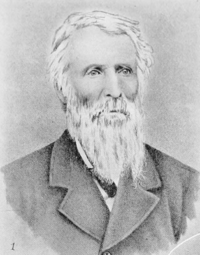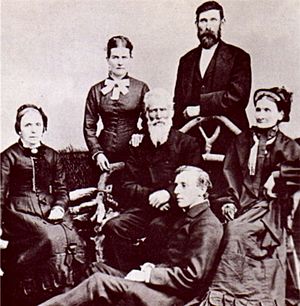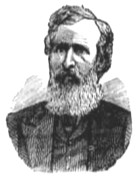Francis Pettygrove facts for kids
Quick facts for kids
Francis Pettygrove
|
|
|---|---|
 |
|
| Born | 1812 |
| Died | October 5, 1887 (aged 74–75) Port Townsend, Washington, U.S.
|
| Resting place | Laurel Grove Cemetery, Port Townsend |
| Nationality | American |
| Other names | William Pettygrove |
| Occupation | Merchant, real-estate investor |
| Known for | One of the founders of Portland, Oregon, and Port Townsend |
| Spouse(s) | Sophia Roland Pettygrove |
Francis William Pettygrove (1812 – October 5, 1887) was an American pioneer. He helped start two important cities: Portland, Oregon, and Port Townsend, Washington.
Francis was born in Maine. In 1843, he moved to the Oregon Country to open a store. He bought half of a piece of land for $50. On this land, he and Asa Lovejoy planned a new town. They couldn't agree on a name. Lovejoy wanted to call it Boston, but Pettygrove wanted Portland. They decided with a coin toss. Pettygrove won, so the town was named Portland, after his home city in Maine.
Later, Pettygrove worked with Benjamin Stark. They traded goods between Portland, San Francisco, and Hawaii. Pettygrove became very wealthy. By 1848, he was one of the richest people in the Oregon Territory. When the California Gold Rush began, many workers left Oregon. Pettygrove decided to sell his businesses and land in Portland. In 1851, he helped start a new town called Port Townsend. This town was in what is now the state of Washington. He lived there until he died at age 75.
Francis Pettygrove was married to Sophia Roland. They had at least two children. While in Oregon, he was part of a literary club. Two places in Portland are named after him: Pettygrove Park and Pettygrove Street.
| Top - 0-9 A B C D E F G H I J K L M N O P Q R S T U V W X Y Z |
Francis Pettygrove's Early Life
Francis Pettygrove was born in Calais, Maine. He went to school in Maine. Later, he worked as a clerk for a merchant in New York City. In 1842, his company sent him to Oregon City to open a store.
Oregon City was then part of the Oregon Country. This area was in the Pacific Northwest. In 1843, Francis, his wife, their child, and his sister's family traveled by ship to Oregon. They stopped in Vancouver first. There, Pettygrove arranged for a boat to take his store goods up the Willamette River to Oregon City. He opened his store with a partner, George Abernethy. Pettygrove built a warehouse and started trading furs and wheat.
Starting a City in Oregon
In 1843, Pettygrove bought 320 acres (1.3 km²) of land from William Overton. This land was along the Willamette River, about 12 miles (19 km) from Oregon City. It was known as The Clearing. Pettygrove and Asa Lovejoy owned land next to each other. They decided to create a town on part of their land.
A sea captain named John Couch thought The Clearing was a great spot for a river port. So, in 1845, Pettygrove and Lovejoy hired Thomas A. Brown to map out the town. Brown and his helper, James Terwilliger, designed the town with 16 square blocks. Each block was 200 feet (61 m) long. They made wide streets for north-south roads and slightly narrower ones for east-west roads.
The town had many tree stumps because they cleared only what was needed. This led to a funny nickname: Little Stump Town.
Lovejoy and Pettygrove couldn't agree on a name for their new town. Lovejoy wanted to name it after Boston, Massachusetts. Pettygrove wanted to name it after Portland, Maine. They decided to settle it with a coin toss. Pettygrove won the best-two-of-three toss. So, the town became Portland.
The two men worked to clear trees from the area. Pettygrove built a small log store near the river. He hired a couple to manage it and also built a wharf. He also got a place to store grain and a boat landing in Champoeg. This was where Oregon's first temporary government was located.
In late 1845, Lovejoy sold his share of the townsite to Benjamin Stark. Stark was in charge of goods being sent from New York to Pettygrove's store. Stark, Pettygrove, and a ship captain named Nathaniel Crosby started trading. They shipped lumber, wheat, and salted fish between San Francisco, Honolulu, and Portland. For a short time, they controlled much of the trade in and out of Oregon.
Pettygrove and Stark also worked on land projects. They built a wagon road between Portland and Oregon City. They also made a wagon track to the farmlands of the Tualatin Plains. Pettygrove built a slaughterhouse to make more money from cattle. He sold animal hides to Daniel H. Lownsdale, who had the first tannery on the Pacific Coast. Pettygrove and Stark were very competitive. They controlled trade between Portland and Hawaii. They charged high prices to bring in goods for others. They also raised the price of salt to control the salmon trade.
In 1847, the United States and the United Kingdom agreed on a border for the Oregon Country. Thousands of pioneers then moved into the Oregon Territory. Most settled in the Willamette Valley. After some disagreements, Stark left town for a while. Pettygrove took control of the entire townsite. By 1848, Pettygrove was one of the richest people in the territory.
In 1849, the California Gold Rush started. Many men left Oregon to search for gold. This caused a shortage of workers in Oregon. Pettygrove saw that Portland might not grow much in the short term. So, he started selling his properties. While Stark was away, Pettygrove sold the entire 640-acre (260 ha) townsite. This included Stark's share. He sold it to Daniel H. Lownsdale for $5,000 worth of leather. This sale made Pettygrove 100 times his original $50 investment!
Moving to Washington
In 1851, Pettygrove and another businessman, L.B. Hastings, decided to start a new town. They chose a spot on the west side of the entrance to Puget Sound in Washington. They met Alfred A. Plummer and Charles Bachelder, who had claimed land near a bay. The four men agreed to found a city there. Pettygrove and Hastings went back to Oregon to get their families and other settlers. They returned to what became Port Townsend. Pettygrove died there in 1887 and is buried in Laurel Grove Cemetery.
Francis Pettygrove's Legacy
Francis Pettygrove married Sophia Roland in 1842. By 1845, they had two children. Their first child was born in the Sandwich Islands (now Hawaiian Islands). Their second child, Benjamin Stark Pettygrove, was the first boy of European descent born in Portland.
Pettygrove was a member of the Pioneer Lyceum and Literary Club in Oregon City. In May 1850, he was the leader of the jury in a trial. This trial was related to events during the Cayuse War.
The copper Matron Head penny from 1835 that Lovejoy and Pettygrove used for their coin flip is famous. Pettygrove gave this penny to the Oregon Historical Society in his will.
Pettygrove Park, a small park in downtown Portland, is named after him. It is one of two parks built in the 1960s. The same penny that named Portland was used again to decide which park would be Lovejoy Park and which would be Pettygrove Park. Lovejoy Fountain Park has water features. Pettygrove Park has grassy hills, trees, paths, and stone designs. Pettygrove Street in northwest Portland is also named for him.



